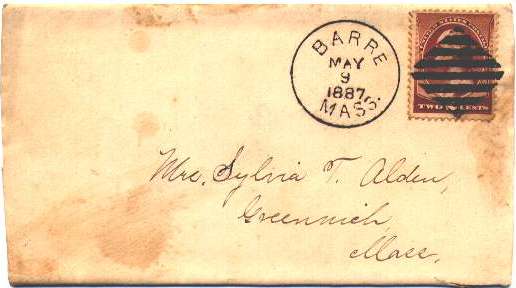
|
The Classic Cancel |
"running man"
Quality 19th Century U.S. Stamps, Cancels and Postal History
|
|
|
|
|
"running man" |
Quality 19th Century U.S. Stamps, Cancels and Postal History |
Analysis of the Barre, Massachusetts Killers, 1880-91 (Page 3)
(Page 1) (Page 2) (Page 4) (Page 5) (Articles Main) (Home)
Table 2 - Killers
|
Killer* |
Description |
|
Grid1 |
29 millimeter round 12-segment open grid |
|
Grid2 |
21x25 millimeter rectangular grid composed of 7 vertical 25 millimeter bars |
|
Grid3 |
18 millimeter squared diamond grid composed of 8 horizontal bars of various lengths |
|
S1 (2) |
Block letter S in 19x30 millimeter segmented vertical box grid composed of 2 horizontal bars above and below the letter and a single vertical bar between 2 squares at left and right |
|
S2 (3) |
Block letter S in 23-24 millimeter vertical ellipse composed of 12 (possibly 13) horizontal bars |
|
S3 (4) |
Reverse block letter S in 25 millimeter circular grid composed of 4 horizontal bars at top and bottom and 4 vertical bars along each side |
|
S4 (5) |
Script letter S in 20 millimeter circular grid composed of 8 horizontal bars |
|
S5 (7) |
Block letter S in 23 millimeter circular grid composed of 7 horizontal bars |
|
R1 (6) |
Thin letter R in 24 millimeter vertical ellipse composed of 11 horizontal bars |
|
H1 (8) |
Block letter H in 23 millimeter vertical ellipse composed of 7 horizontal bars |
|
B1 (12) |
Block letter B in 24 millimeter pointed vertical ellipse composed of 7 horizontal bars |
|
J1 (13) |
Block letter J in 22 millimeter circular grid composed 7 horizontal bars |
|
J2 (11) |
Block letter J in 20x22 millimeter vertical box grid composed of 2 horizontal bars above and below the J and 3 horizontal bars at left and right |
|
J3a |
Small block letter J in 19-20x13 millimeter horizontal box grid composed of single short bar and circular arch above and below the J and 2 vertical bars at left and right |
|
J3b (16) |
Small block letter J in 19-20x13 millimeter horizontal box grid composed of single short bar above and below the J and 2 vertical bars at left and right |
|
W1 (10) |
Small block letter W in 24 millimeter circular grid composed of 9 horizontal bars around small interior block |
|
W2a (9) |
Block letters W and H (latter smaller and within the W) in 23 millimeter circular grid composed of 9 horizontal bars |
|
W2b (14) |
Same as Killer P1 with the letter H removed |
|
W2c (19, 20) |
Same as Killer P2 (worn state) missing the short horizontal bars along either side of the letter W |
|
W3 (21) |
Small block letter W in circular grid composed of 8(?) horizontal bars around large interior block |
|
MJC1 (17) |
Block letters MJC horizontally arrayed in 23 millimeter circular grid with 2 horizontal bars above and below the letters |
|
OC1 (18) |
Block letters OC horizontally arrayed in 23 millimeter circular grid composed of 3 vertical segments above and below the letters and 3 horizontal segments at left and right |
|
K1 |
Single sold trapezoidal block 15x15x17 millimeters containing a negative letter K set horizontally in the killer |
|
Mx1 (15) |
Solid Maltese cross within 22 millimeter circular grid composed of a single horizontal bar above and below the cross and a single vertical bar at left and right |
|
* Number in parenthesis represents the illustration figure number from the August 2001 article. |
|
By 1886 it appears that the practice of double cancellation ceased. Instead, the various killers were locked into a duplexed cancellation device composed of a 27-millimeter metal rimmed postmark reading "BARRE" at top and "MASS." at the bottom. A number of dial variations exist for this device. (See Table 1.) It appears that the Barre post office used dial varieties 5, 6 and 8 from mid-to-late 1886 through mid-1888. These dial types consist of a three line date composed of month, day and year. Dial type 7, composed of a four line month, day, time and year, appears to have seen use from late 1887 through late 1889. Finally, dial type 9 shows use from early 1890 well into 1891, for the covers examined.

Figure 4